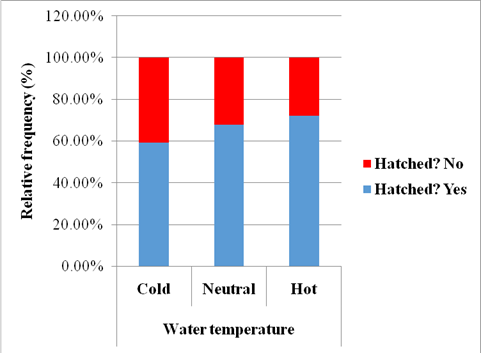
a.
To find what proportion of the water python eggs that hatched were randomly assigned to hot water.
a.
Answer to Problem 32E
About 0.5814 of the hatched eggs were assigned to hot water.
Explanation of Solution
Given:
| Water temperature | |||||
| Cold | Neutral | Hot | Total | ||
| Hatched? | Yes | 16 | 38 | 75 | 129 |
| No | 11 | 18 | 29 | 58 | |
| Total | 27 | 56 | 104 | 187 | |
Calculation:
The study includes 187 eggs (as the value 187 is mentioned in the bottom right corner of the given table).
| Water temperature | |||||
| Cold | Neutral | Hot | Total | ||
| Hatched? | Yes | 16 | 38 | 75 | 129 |
| No | 11 | 18 | 29 | 58 | |
| Total | 27 | 56 | 104 | 187 | |
We note that 129 of the 187 eggs hatched (as 129 is mentioned in the row "Yes" and in the column "Total" of the given table).
Moreover, we also note that 75 of the 129 hatched eggs were assigned to hot water (as 75 is mentioned in the row "Yes" and in the column "Hot" of the given table).
Thus about 0.5814 of the hatched eggs were assigned to hot water.
b.
To find what percentage of the water python eggs that were randomly assigned to hot water have hatched.
b.
Answer to Problem 32E
About 72.12% of the eggs assigned to hot water have hatched.
Explanation of Solution
Given:
Researchers randomly assigned newly laid water python eggs to one of three water temperatures: hot, neutral, or cold. Hot duplicates the extra warmth provided by the mother python, and cold duplicates the absence of the mother. The below two-way table summarizes the data on whether or not the eggs hatched.
| Water temperature | |||||
| Cold | Neutral | Hot | Total | ||
| Hatched? | Yes | 16 | 38 | 75 | 129 |
| No | 11 | 18 | 29 | 58 | |
| Total | 27 | 56 | 104 | 187 | |
Calculation:
The study includes 187 eggs (as the value 187 is mentioned in the bottom right corner of the given table).
| Water temperature | |||||
| Cold | Neutral | Hot | Total | ||
| Hatched? | Yes | 16 | 38 | 75 | 129 |
| No | 11 | 18 | 29 | 58 | |
| Total | 27 | 56 | 104 | 187 | |
We note that 104 of the 187 eggs were assigned to hot water (as 104is mentioned in the row "Total" and in the column "Hot" of the given table).
Moreover, we also note that 75 of the 104eggs assigned to hot water have hatched (as 75 is mentioned in the row "Yes" and in the column "Hot" of the given table).
Thus about 72.12% of the eggs assigned to hot water have hatched.
c.
To describe the segmented bar graph that displays the distribution of hatching status by water temperature and what it actually reveals about the association between these two variables for the python eggs in this experiment.
c.
Answer to Problem 32E
Eggs appears to be more likely to hatch as the temperature increases. We note that for each temperature, the majority of the eggs latch.
Explanation of Solution
The below segmented bar graph displays the information about the distribution of hatching status (%) by water temperature:

We note that eggs appears to be more likely to hatch as the temperature increases, because when comparing the blue parts of the bars of the segmented bar graph, we note that the blue section is smallest for "Low" and largest for "High" temperature.
We note that for each temperature, the majority of the eggs hatch, because the blue section of each bar is larger than the red section of the bar.
Chapter 1 Solutions
PRACTICE OF STATISTICS F/AP EXAM
Additional Math Textbook Solutions
Elementary Statistics
Introductory Statistics (2nd Edition)
Basic Business Statistics, Student Value Edition (13th Edition)
Introductory Statistics
Elementary Statistics: Picturing the World (6th Edition)
 MATLAB: An Introduction with ApplicationsStatisticsISBN:9781119256830Author:Amos GilatPublisher:John Wiley & Sons Inc
MATLAB: An Introduction with ApplicationsStatisticsISBN:9781119256830Author:Amos GilatPublisher:John Wiley & Sons Inc Probability and Statistics for Engineering and th...StatisticsISBN:9781305251809Author:Jay L. DevorePublisher:Cengage Learning
Probability and Statistics for Engineering and th...StatisticsISBN:9781305251809Author:Jay L. DevorePublisher:Cengage Learning Statistics for The Behavioral Sciences (MindTap C...StatisticsISBN:9781305504912Author:Frederick J Gravetter, Larry B. WallnauPublisher:Cengage Learning
Statistics for The Behavioral Sciences (MindTap C...StatisticsISBN:9781305504912Author:Frederick J Gravetter, Larry B. WallnauPublisher:Cengage Learning Elementary Statistics: Picturing the World (7th E...StatisticsISBN:9780134683416Author:Ron Larson, Betsy FarberPublisher:PEARSON
Elementary Statistics: Picturing the World (7th E...StatisticsISBN:9780134683416Author:Ron Larson, Betsy FarberPublisher:PEARSON The Basic Practice of StatisticsStatisticsISBN:9781319042578Author:David S. Moore, William I. Notz, Michael A. FlignerPublisher:W. H. Freeman
The Basic Practice of StatisticsStatisticsISBN:9781319042578Author:David S. Moore, William I. Notz, Michael A. FlignerPublisher:W. H. Freeman Introduction to the Practice of StatisticsStatisticsISBN:9781319013387Author:David S. Moore, George P. McCabe, Bruce A. CraigPublisher:W. H. Freeman
Introduction to the Practice of StatisticsStatisticsISBN:9781319013387Author:David S. Moore, George P. McCabe, Bruce A. CraigPublisher:W. H. Freeman





